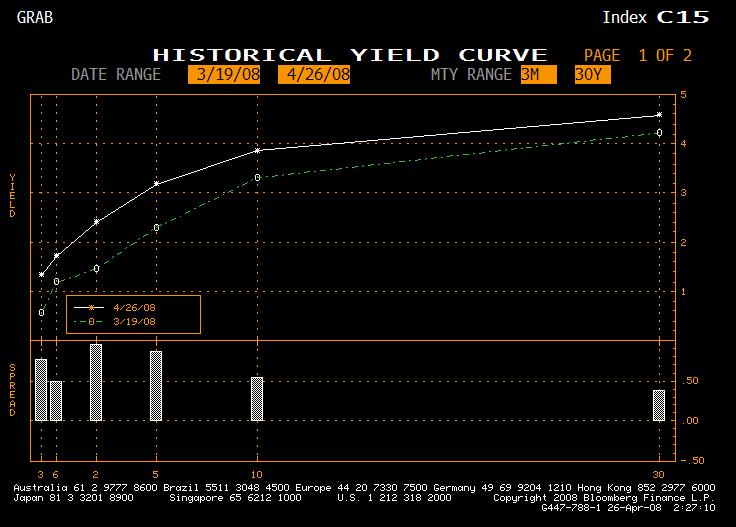Still Too Early For Banks
One thing about Jim Cramer, he is quotable.? Take this short bit from his piece, Graybeards Get It Wrong on Financials.
One of the loudest and most pervasive themes by a lot of the graybeards is that there is still much more pain ahead in the financials.Let me explain why that is wrong. First, the group is down from a year ago. It’s been hammered mercilessly.
More important, every time the stock market rallies is another chance for these companies to refinance.
Remember, as they go up, the companies are in shape to tap the equity market again because those who bought lower are being rewarded, psyching others to take a chance. In fact, other than the monoline insurance faux bailouts, people who pony up are doing pretty well.
Now, he might be right, and me wrong on this point (with my gray beard, though I am younger than he is).? But let me point out what has to go right for his forecast to be correct.
1) The inventory of vacant homes has to start declining.? Still rising for now, another new record.? Beyond that, you have a lot of what I call lurking sellers around, waiting to put more inventory out onto the market, if prices rise a little.? They will have to wait a while, and many will lose patience and sell anyway.? There is still to much debt financing our housing stock, and though most of the subprime shock is gone, much of the shock from other non-subprime ARMs that will reset remains.? Will prices drop from here by 20%?? I think it will be more like 12%, but if it is 20% there will be many more foreclosures, absent some change in foreclosure laws.? Foreclosures happen when a sale would result in a loss, and a negative life event hits — death, divorce, disaster, disability, and unemployment.
2) We still have to reconcile a lot of junk corporate debt issued from 2004-2007, much of which is quite weak.? Credit bear markets don’t end before you take a lot of junk defaults, and we have barely been nicked.? Yes, we have had a sharp rally in credit spreads over the last five weeks, but bear market rallies in credit are typically short, sharp, and common, keeping the shorts/underweighters on their toes.? You typically get several of them before the real turn comes.
3) We have not rationalized a significant amount of the excess synthetic leverage in the derivatives market.? With derivatives for every loser, there is a winner, but the question is how good the confidence in creditworthiness between the major investment banks remains.? Away from that, Wall Street will be less profitable for some time as securitization, and other leveraged businesses will recover slowly.
4) Credit statistics for the US consumer continue to deteriorate — if not the first lien mortgages, look at the stats on home equity loans, auto loans, and credit cards.? All are doing worse.
5) Weakness in the real economy is increasing as a result of consumer stress.? Will real GDP growth remain positive?? I have tended to be more bullish than most here, but the economy is looking weaker.? Let’s watch the next few months of data, and see what wanders in… I don’t see a sharp move down, but measured move into very low growth in 2008.
6) What does the Fed do?? Perhaps they can take a page from Cramer, and look at the progress from private repair of the financial system through equity and debt issuance.? It’s a start, at least.? But the Fed has increasingly encumbered is balance sheet with lower quality paper.? Two issues: a) if there are more lending market crises, the Fed can’t do a lot more — maybe an amount equal to what they have currently done.? b) What happens when they begin to collapse the added leverage?? Okay, so they won’t do it, unless demand goes slack… that still leaves the first issue.? There are limits to the balance sheet of the Fed.
Beyond that, the Fed faces a weak economy, and rising inflation.? Again, what does the Fed do?
7) Much of the inflation pressures are global in nature, and there is increasing unwillingness to buy dollar denominated fixed income assets.? The books have to balance — our current account deficit must be balanced by a capital account surplus; the question is at what level of the dollar do they start buying US goods and services, rather than bonds?
8 ) Oh, almost forgot — more weakness is coming in commercial real estate, and little of that effect has been felt by the investment banks yet.
As a result, I see a need for more capital raising at the investment banks, and more true equity in the capital raised.? Debt can help in the short run, but can leave the bank more vulnerable when losses come.? The investment banks need to delever more, and prepare for more losses arising from junk corporates and loans, housing related securities, and the weak consumer.



 A word before I start: I’m averaging two book review requests a month at present. I tell the PR people that I don’t guarantee a review (though I have reviewed them all so far), or even a favorable review. They send the books anyway.
A word before I start: I’m averaging two book review requests a month at present. I tell the PR people that I don’t guarantee a review (though I have reviewed them all so far), or even a favorable review. They send the books anyway.
